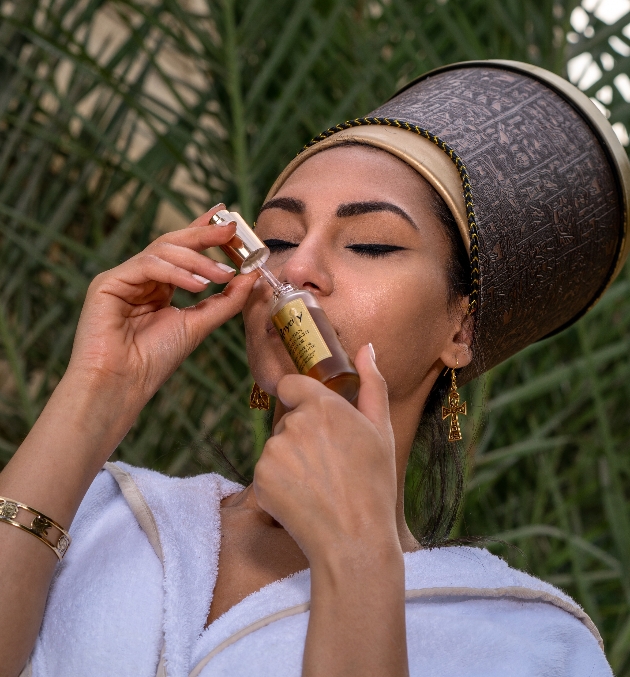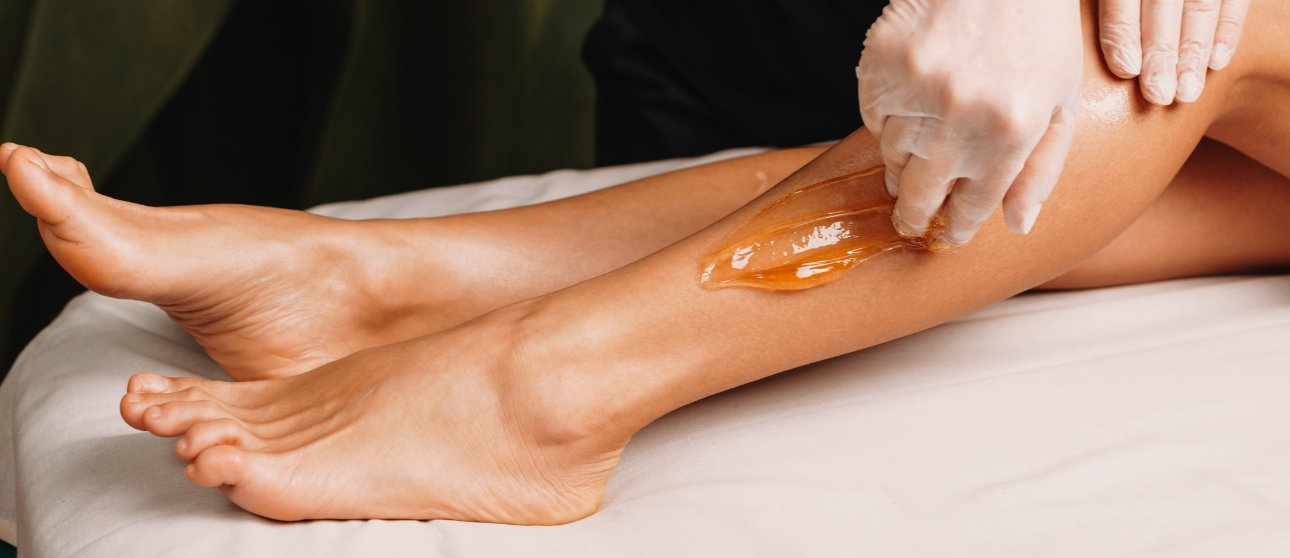Loving Tan has brought its newest Purest Collection to the UK
With consumer demand for natural and organic products on the rise, Loving Tan has...
Randa Zaid from Hayaty Natural tells us what we can learn from the Ancient Egyptians when it comes to caring for our skin.

Ancient Egypt wasn’t just pharaohs and slaves – there were many occupations ranging from bakers to soldiers, from fishermen to scribes. They were obsessed with health and beauty, and they did know a thing or two about skin care – especially where exposure to the sun was concerned. If you want to look your best on your big day (especially if that day falls in the middle of summer) there is much to be gleaned from the knowledge of ancient Egypt.

FOOD FIRST
The ancient Egyptians firmly believed that if you eat well, you look well. Hieroglyphics on ancient Egyptian walls left behind a record of what they ate and drank. Beekeeping began there as early as 2400 BC. They loved their honey.
In 450 BC Greek historian Herodotus wrote that ‘Egypt was a gift of the Nile.’ When this great river used to burst its banks annually, the receding waters left a black, fertile mud, rich in minerals. An abundance of pomegranate, dates, grapes, watermelon, garlic, cucumbers, carrots, celery and peas grew, as did dates. With a diet like that, the ancient Egyptians were feeding their bodies and their skin with a rich source of antioxidants, protein and fibre.
Take a good look at your own eating habits and make appropriate adjustments.
OUT WITH THE OLD (SKIN)
The ancient Egyptians are credited with the first exfoliation techniques – they used a combination of pumice stones and scrubs made from sand or plants such as aloe vera. Natron (sodium carbonate) mixed with water was used as a scrub. Modern baking soda is a gentle substitute for Natron. While it is a mild exfoliator, it shouldn’t be done more than once a week.
You could also try many of the mineral sea salt scrubs on the market or alternatively, look out for a good Egyptian organic loofah. It’s not too hard or soft, the perfect texture for a good scrub. Be warned, it has an earthy, muddy smell but you get used to it. They are sold by men with carts on the street all over Egypt, but they are just as easily found online or in good, organic health shops.

HAIR TODAY, GONE TOMORROW
For the ancient Egyptians, being hairless was the gold standard of cleanliness as they had no access to hygiene products such as deodorants, So, living in the soaring temperatures of the hot desert made hair removal a must for comfort. Alexander the Great always charged into battle clean-shaven and hairless. The natural method of hair removal, sugaring, was invented by the ancient Egyptians. They made their paste out of balls of a honey mixture (moum).
Sugaring has gained popularity over the world in recent years. It’s better for the environment and less painful than waxing as it binds directly to the hair not the skin. Some Egyptian women today still use sugar and lime juice instead of honey.
ALOE VERA AND AVOCADO
Dark circles and puffy eyes are not a modern phenomenon. The ancient Egyptians were using slices of nutrient rich avocado under their eyes way back then. They believed avocados were the food of the gods. Rich in potassium, vitamins, fats and protein, whether you slap it on your skin or eat it, the avocado is the health supplement that really does grow on trees.
The nourishing effects of aloe vera were documented in the Eber Papyrus as far back as 1550 BC. But its reference as the ‘plant of immortality’ was not because it makes you live for ever, but its multiple uses. Cleopatra and Nefertiti were believed to have used it on their faces as a nourishing and tightening mask.
The plant has more than 75 nutrients including Vitamins A, C and E and B12 and amnio acids. As well as being anti-inflammatory, it is super hydrating, reduces swelling, stimulates collagen production and increases the rate of healing, especially after sunburn. The Egyptians depicted the plant all over their temple walls.
There are myriad products on the market containing aloe vera, but the simplest thing is to get a plant from any garden centre, cut open the leaf, scoop out the sticky gel inside and apply to the face. Rinse off with warm water after around 10 minutes for firm, smooth and beautifully moisturised skin. Alternatively for very dry skin, Shea butter was a big part of ancient Egyptian civilisation. Anthropologists discovered it was the go-to for skin disease. It contains huge amounts of fatty acids to moisturise and soothe and it also protects against short waves of blue light.

OILS WELL THAT ENDS WELL
Soaking up the summer sun can leave skin parched. The ancient Egyptians (who had access to more than 20 essential oils, according to the Ebers Papyrus), slathered themselves in pungent oils to keep their skin from drying out in the fierce desert heat. Frankincense, cedar, lupin, black seed, rose, fenugreek and sesame can all be bought individually and added to a carrier massage oil such as sweet almond or look for the ingredients on commercial moisturising oils.
Frankincense: One of the seven sacred oils on display in the Museum of Cairo, this was central to worshiping the gods and was burned to rid the air of bacteria. Historically used for scars, the Ebers Papyrus notes its ‘superior wound healing effects’ its powerful antioxidants are believed to slow down the ageing process, especially on mature skins – so look out for it as ingredient when buying night repair creams. It also smells amazing.
Lupin Seed: The first oil recorded in ancient Egypt where it was used to protect against sunburn. Rich in antioxidants, it promotes elasticity, nourishes, hydrates and illuminates. Look out for this ingredient in your skincare products as it will give your skin a wonderful glow.
Black Seed: Nutrient dense and anti-inflammatory. Used in ancient Egypt to treat bites and rashes. Can also help to clear eczema, acne and psoriasis. Archaeologists point to its great significance for protection and healing after finding the seeds in Tutankhamun’s tomb. This wonder seed is so versatile and has so many benefits that it should be a ‘must have’ in any skincare product you choose.
Sesame: Listed in the Ebers Papyrus as Sesemt, baskets of sesame were found in King Tutankhamun’s tomb. It was used to treat inflammation and today its anti-microbial properties are used for fighting acne.
Fenugreek: One of Cleopatra’s favourites. Slows the signs of ageing.
Rose: This flower was incredibly important to the ancient Egyptians as they believed it had powerful healing and aphrodisiac properties. They would boil down roses to use as a skin balm. It was the symbol of the Egyptian Goddess of Love, Isis, and depicted on many works of ancient Egyptian art. It’s a great skin moisturiser and the scent reduces anxiety.
NO NEED FOR A MILK BATH
Egyptian queens Cleopatra and Nefertiti were known for their love of milk and honey baths and the combination does make a great cleanser, leaving the skin soft and silky. However, that’s not practical, or environmentally sound in today’s world. You could use a substitute like coconut milk mixed with warm water but better still check out cleansing products containing hydroxy and lactic acid. Milk is rich in lactic acid and listed in many skin care products (AHA). It helps remove dead skin cells and stimulates new cell growth.
Olive oil was also a favourite of the ancient Egyptians who spread it all over their skin to stick to the dirt before scraping it off. The Ebers Papyrus instructed people to mix animal and vegetable oils with alkaline salts for washing and the olive oil soap we buy today is known for its lower pH than mainstream soaps that can dry and irritate the skin. It’s deeply nourishing, moisturising and anti-oxidant rich. A very gentle cleanser that can be used on the face without stripping out its natural oils.
Many of the skin care rituals we practice today are thought to have originated in Egypt more than 5,000 years ago. Pictures of washing rituals have been revealed on hundreds of artefacts found at excavations over the years and ancient papyrus papers show the Egyptians relied heavily on plants and herbs for their skin care. Cleanse, treat, moisturise was their mantra so the basic principle hasn’t really changed – there’s just a lot less donkey milk involved now.
Hayaty Natural is a genderless skincare brand inspired by the wisdom of the Ancient Egyptians. Using medicinal botanicals like and a combination of plant-based ingredients sourced from local communities in Randa’s homelands of Egypt and Italy, each formulation follows ancient recipes developed by the Pharaohs to provide an holistic approach to self-care.
Hayaty is Organic, Vegan, Fairtrade, Cruelty- and GMO-free. Packaged in recyclable glass and card, each bottle comes with a hand-made Egyptian papyrus to inspire us to love ourselves and our environment.
Check out https://hayatynatural.uk